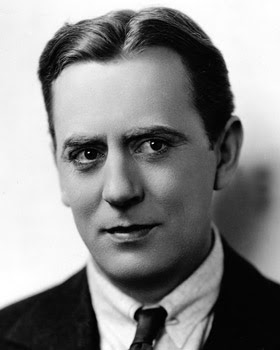 |
| [Photo: Freulich/Universal Pictures] |
1888-1960
Youngest of the Moore Brothers from County Meath, Ireland, Matt Moore was born today two years after his brother Owen and 5 years after the eldest Tom. The brothers immigrated to the U.S. in 1896 on the cheapest passage on a passenger liner, passing thorough the Ellis island gateway in May of that year. Matt's career was longer than that of his older brothers, but only just in the case of Tom. His career during the silent era was very successful. Moore made his debut in the film Tangled Relations in 1912; a production made by Victor Film (the company set up by Florence Lawrence and her husband Harry Solter with backing by Carl Laemmle) where his brother Owen was already working. From here, he went to work at Laemmle's IMP, next showing up in the George Loane Tucker film Just A Fire Fighter in 1913 (Moore also appeared in Tucker's 1913 Traffic in Souls the rather infamous [due to it's subject matter] 6-reel "white slavery" film). His appearances in films at the company over the next year were mostly opposite Jane Gail, who starred in a number "Jane" films for the studio. In fact, it was on a "Jane" picture later in 1917 that he first sat behind the camera for the first time on Plain Jane, a film that he also appeared in. Moore would go on to have 18 credits for directing between 1913 and 1917. The vast majority of the films were shorts featuring himself and Gail--the last of these was The Brass Girl (1917). In the meantime, he was on the set of The Pawn of Destiny in 1914, when the infamous set fire broke out that essentially ended her career. He was the actor that the studio claimed that the diminutive actress was supposed to have saved single-handedly. Of course, it was just a press fabrication and one that must of have mortified Moore. Two years later he would go on to his most important role of the teens in the underwater extravaganza 20,000 Leagues Under The Sea, which was directed by Laemmle himself and was a cinema first in terms of undersea camera work. By 1920 Moore was still appearing in films being produced in the New York area; late for the time period when the majority of studios had made the major move west. In the early 1920's he found himself working for the Selznick Pictures Corp. By 1922 Moore had moved over to films produced at Universal (Lewis Selznick's company would not survive much longer). Universal's The Storm (1922) may not have been the first film that he acted in California (it likely is), but, certainly by this time, he had made the westward move at last. By the mid-1920's he had also made films for both MGM and the new studio in town: Warner Brothers. In 1925 he had a major role in the one silent film that he is remembered for; he assayed the role of the straight man Hector McDonald in Tod Brownings famous crime film The Unholy Three, starring amongst others, Lon Chaney Sr. And, by the late 1920's, he had become a kind of comedy specialist, taking top billing in a number of feature length domestic follies. He was also at the top of the bill for a couple of mystery films that did quite well at the box office. These titles include Tillie the Toiler (1927) starring Marion Davies, Diplomacy (1926) with Blanche Sweet and Three Weeks in Paris (1925) which was penned by Darryl J. Zanuck. The first film that he worked on that had sound was the partial silent Dry Martini in 1928; the film starred Mary Astor and featured a MovieTone musical score. His very next film, Coquette (1929), was a full talkie of his career, and featured his sister-in-law at the time Mary Pickford (who was married to his brother Owen). Moore weathered the transition to sound just fine (as did his brothers), his turn in the Joan Crawford film of 1932 Rain, shows his bankability in the new talking era. He worked continuously throughout the 1930's and 1940's, though by the late 1940's his roles had dwindled to small to uncredited. He lived long enough to debut on the small screen as well. In 1955 he played a judge in an episode of Screen Directors Playhouse; and he went on to make a couple of more television appearances in his lifetime. The last film that he appeared in was the B-horror mystery I Bury The Living in 1958. Matt Moore passed away in Hollywood on the 20th of January in 1960, just a couple of weeks after his 72nd birthday. He is buried (along with his brother Tom) in Calvary Cemetery in East Los Angeles.
IMDb
Wikipedia
Leave Virtual Remembrances @ Find A Grave
IMDb
Wikipedia
Leave Virtual Remembrances @ Find A Grave

No comments:
Post a Comment